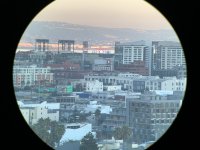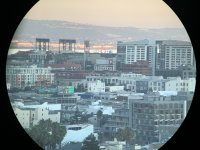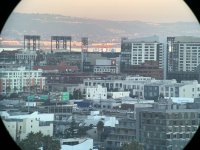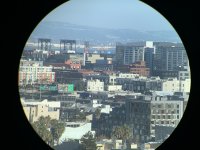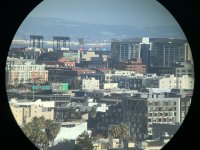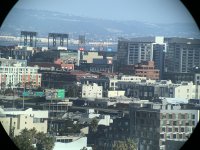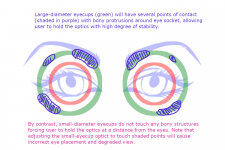Good day, birders and optics enthusiasts,
The Swaro CL-B Companion binoculars were recently on sale at one of the retailers here in the US, so I decided to try out a pair, to see if I could replace the Kowa 8x33 Genesis I own, with an eye on saving weight. Not to say that the Genesis bins are a heavyweight in absolute terms, but after acquiring the NL Pure 10x42 last fall with which I am greatly pleased, I thought I could get away with something lighter for long hikes as, ahem, a companion instrument. The NLs have made me somewhat of a Swarovski fanboy, so try out I did. I will spare the reader the annoyance of reading the full review, and jump to the conclusion right away: the Companion-Bs are a practically unusable instrument without glasses. This is a deal-killer for me, so I am returning them right away. Still, I will share my impressions of these binoculars in case there are people here who wear glasses always.
I have previously reviewed the other two bins from the current trio over here.
Intro
------
To start, I was quite impressed with the CLs immediately after opening the box. Very slim (too slim, as I learned later!), very solidly built for their size, and very nice to hold. The only flaw that immediately jumped out was that the focus wheel was stiff and uneven. This certainly could be due to sample variation (plus, my copy was a demo version and not completely brand new). In the afternoon sun that day, the Companions seemed very sharp. They did show chromatic aberration, but I thought it was not overly annoying. When focused properly and with eyes set properly, it largely disappeared, though I could still see it in the out-of-focus background when looking through a tree outside. Besides the weight, my other concern with the Kowa Genesis 8x33 was its quite narrow sweet spot. The CL-Bs have a much wider sweet spot although their field of view is narrower than that of the Kowa's.
But then, disaster struck.... I arrived to my home base and I tried out these bins next to Kowa 8x33. As the sun set and dusk set in, I noticed that the image in Kowas is almost an order of magnitude more relaxing to look at. The image in the NLs was better still, but I noticed that I could use either the Kowa or the NL at this hour, while I could not use the CL-B at all. The natural question that arose: why? Do the extra 3mm in the objective diameter really make that much of a difference?
As it turns out, the problem was largely caused by eyecup ergonomics. The eyecups on the CL-B are so narrow it is impossible to press them against the eye-socket -- they end up touching the eye itself rather than the eye socket, which is painful, so the natural impulse is to hold them entirely in one's hands, at a slight distance from the eyes. Now, holding the binoculars like that removes the whatever stability is provided by pressing the oculars against the eye sockets, and it turns out that that extra stability is a big deal, even at 8x power. That, coupled with slightly lower contrast and with slightly smaller exit pupil means that the 8x30 Companion-Bs binoculars are dramatically less usable in the dark compared to a full-size 8x32 or 8x33, while still being uncomfortably shaky even in bright sun. With glasses on, the stability of the Companions improves, but I simply do not enjoy watching the world through so many layers of glass! If the Companions were perfect optically, I might have considered keeping them, but their optics, while good, are not perfect.
Optical observations
--------------------
1. Chromatic aberration. Not overly objectionable, but present at a significantly higher level than the Kowa or the NL Pure. The amount of CA one sees the CLs depends on eye placement. If the eyes are placed perfectly, there is very little CA, but otherwise one sees CA, even in the center of the image. This can get annoying when scanning trees for warblers and similar.
2. Sharpness. The CL-B sweet spot size is impressive, with nearly entire field being sharp. The center sharpness is very good, though the Kowa seems to provide very slightly more detail in the absolute center due to slightly higher real magnification (the AllBinos review listed Genesis' real magnification as 8.2x, and my rough pixel measurements give 8.25x).
3. Contrast. The contrast on the CL-B is slightly lower than on the Kowa. Both optics pale in comparison to the NL Pure (see photos attached).
4. Field of view. The 7.6 degrees on the CL-B is just a bit constraining for me. The Genesis 8x33 has a larger FOV (8 degrees), which I deem satisfactory for an 8-power. In terms of apparent field of view, both pale in comparison to the NL Pures, but I find that the Kowa view is sufficiently wide.
5. Distortion is lower than on the Kowa Genesis, but I could live with either.
6. Color. Typical Swarovski color -- very neutral, with good transmission in the blue side of the spectrum. Some people don't like this, but I like Swarovski colors. I find they allow for good separation of color on the subject when the sky is overcast. By contrast, some binos (like the Genesis here, but especially some Zeisses) are known to compress the color palette to the yellow-greens, reducing the scene to dull-brownish hues under overcast conditions, which is not my preference.
Ergonomics
------------
As mentioned, the narrow eyecups that press against my eyeball are a deal breaker for me. I do not think this is due to my eye sockets being too large or anything like that. My face is quite normal-sized. I believe that these binoculars (as many other compacts on the market probably) are designed for use with glasses, such that one can press them against glass for stability. I find that very unfortunate. In the bright sun, one often wears sunglasses or shaded prescription glasses that hinder the view. In the dusk, one wants every last bit of light, and so one takes off the glasses. But the slim instruments look sexy, so they sell.
Other than the eyecups, the focus wheel has serious problems for a $1,000-priced pair of binoculars. This particular CLs wheel is a disaster. I do not understand why it is so difficult for manufacturers to design a good focus wheel. The Kowa focus wheel is almost perfect -- if only it were less difficult to use one-handed. The NL Pures' focus wheel is a lot more usable with one hand, but my copy has some play (I am reluctant to turn them in to Swarovski for service as I am concerned they could make it too stiff).
Diopter. The CLs have been criticized for their center diopter being difficult to set without removing the eye from the oculars. I managed to do so somehow without much issue (it probably helped that one has to hold them at a distance to begin with, heh). With either Swarovski, I found that setting the diopter is "set once and forget" experience, while the Kowa is more fidgety, likely due to its narrow sweet spot fooling either one or the other eye while adjusting the diopter.
Conclusion
-----------
This experience was interesting for me. I learned that I will probably never own a pair of true pocket binoculars as I simply cannot tolerate narrow eyecups. Also, I learned that, despite what is often said online, a photo through the optics with a simple phone camera (I used an iPhone) actually does provide a good yardstick for contrast, particularly if one takes a picture of the exact same scene in rapid succession through different optics. The "through-the-lens" pictures are generally a less reliable indicator of color (most phone cameras will apply auto white-balance that cannot be turned off), and obviously are not useful at all for things like ease-of-view.
Attachments
-------------
The first three were taken just before sunset (contrast differences visible in the shadows), the other three in the afternoon. Each series is in this order: 1) CL-B, 2) Genesis, 3) NL Pure.
The Swaro CL-B Companion binoculars were recently on sale at one of the retailers here in the US, so I decided to try out a pair, to see if I could replace the Kowa 8x33 Genesis I own, with an eye on saving weight. Not to say that the Genesis bins are a heavyweight in absolute terms, but after acquiring the NL Pure 10x42 last fall with which I am greatly pleased, I thought I could get away with something lighter for long hikes as, ahem, a companion instrument. The NLs have made me somewhat of a Swarovski fanboy, so try out I did. I will spare the reader the annoyance of reading the full review, and jump to the conclusion right away: the Companion-Bs are a practically unusable instrument without glasses. This is a deal-killer for me, so I am returning them right away. Still, I will share my impressions of these binoculars in case there are people here who wear glasses always.
I have previously reviewed the other two bins from the current trio over here.
Intro
------
To start, I was quite impressed with the CLs immediately after opening the box. Very slim (too slim, as I learned later!), very solidly built for their size, and very nice to hold. The only flaw that immediately jumped out was that the focus wheel was stiff and uneven. This certainly could be due to sample variation (plus, my copy was a demo version and not completely brand new). In the afternoon sun that day, the Companions seemed very sharp. They did show chromatic aberration, but I thought it was not overly annoying. When focused properly and with eyes set properly, it largely disappeared, though I could still see it in the out-of-focus background when looking through a tree outside. Besides the weight, my other concern with the Kowa Genesis 8x33 was its quite narrow sweet spot. The CL-Bs have a much wider sweet spot although their field of view is narrower than that of the Kowa's.
But then, disaster struck.... I arrived to my home base and I tried out these bins next to Kowa 8x33. As the sun set and dusk set in, I noticed that the image in Kowas is almost an order of magnitude more relaxing to look at. The image in the NLs was better still, but I noticed that I could use either the Kowa or the NL at this hour, while I could not use the CL-B at all. The natural question that arose: why? Do the extra 3mm in the objective diameter really make that much of a difference?
As it turns out, the problem was largely caused by eyecup ergonomics. The eyecups on the CL-B are so narrow it is impossible to press them against the eye-socket -- they end up touching the eye itself rather than the eye socket, which is painful, so the natural impulse is to hold them entirely in one's hands, at a slight distance from the eyes. Now, holding the binoculars like that removes the whatever stability is provided by pressing the oculars against the eye sockets, and it turns out that that extra stability is a big deal, even at 8x power. That, coupled with slightly lower contrast and with slightly smaller exit pupil means that the 8x30 Companion-Bs binoculars are dramatically less usable in the dark compared to a full-size 8x32 or 8x33, while still being uncomfortably shaky even in bright sun. With glasses on, the stability of the Companions improves, but I simply do not enjoy watching the world through so many layers of glass! If the Companions were perfect optically, I might have considered keeping them, but their optics, while good, are not perfect.
Optical observations
--------------------
1. Chromatic aberration. Not overly objectionable, but present at a significantly higher level than the Kowa or the NL Pure. The amount of CA one sees the CLs depends on eye placement. If the eyes are placed perfectly, there is very little CA, but otherwise one sees CA, even in the center of the image. This can get annoying when scanning trees for warblers and similar.
2. Sharpness. The CL-B sweet spot size is impressive, with nearly entire field being sharp. The center sharpness is very good, though the Kowa seems to provide very slightly more detail in the absolute center due to slightly higher real magnification (the AllBinos review listed Genesis' real magnification as 8.2x, and my rough pixel measurements give 8.25x).
3. Contrast. The contrast on the CL-B is slightly lower than on the Kowa. Both optics pale in comparison to the NL Pure (see photos attached).
4. Field of view. The 7.6 degrees on the CL-B is just a bit constraining for me. The Genesis 8x33 has a larger FOV (8 degrees), which I deem satisfactory for an 8-power. In terms of apparent field of view, both pale in comparison to the NL Pures, but I find that the Kowa view is sufficiently wide.
5. Distortion is lower than on the Kowa Genesis, but I could live with either.
6. Color. Typical Swarovski color -- very neutral, with good transmission in the blue side of the spectrum. Some people don't like this, but I like Swarovski colors. I find they allow for good separation of color on the subject when the sky is overcast. By contrast, some binos (like the Genesis here, but especially some Zeisses) are known to compress the color palette to the yellow-greens, reducing the scene to dull-brownish hues under overcast conditions, which is not my preference.
Ergonomics
------------
As mentioned, the narrow eyecups that press against my eyeball are a deal breaker for me. I do not think this is due to my eye sockets being too large or anything like that. My face is quite normal-sized. I believe that these binoculars (as many other compacts on the market probably) are designed for use with glasses, such that one can press them against glass for stability. I find that very unfortunate. In the bright sun, one often wears sunglasses or shaded prescription glasses that hinder the view. In the dusk, one wants every last bit of light, and so one takes off the glasses. But the slim instruments look sexy, so they sell.
Other than the eyecups, the focus wheel has serious problems for a $1,000-priced pair of binoculars. This particular CLs wheel is a disaster. I do not understand why it is so difficult for manufacturers to design a good focus wheel. The Kowa focus wheel is almost perfect -- if only it were less difficult to use one-handed. The NL Pures' focus wheel is a lot more usable with one hand, but my copy has some play (I am reluctant to turn them in to Swarovski for service as I am concerned they could make it too stiff).
Diopter. The CLs have been criticized for their center diopter being difficult to set without removing the eye from the oculars. I managed to do so somehow without much issue (it probably helped that one has to hold them at a distance to begin with, heh). With either Swarovski, I found that setting the diopter is "set once and forget" experience, while the Kowa is more fidgety, likely due to its narrow sweet spot fooling either one or the other eye while adjusting the diopter.
Conclusion
-----------
This experience was interesting for me. I learned that I will probably never own a pair of true pocket binoculars as I simply cannot tolerate narrow eyecups. Also, I learned that, despite what is often said online, a photo through the optics with a simple phone camera (I used an iPhone) actually does provide a good yardstick for contrast, particularly if one takes a picture of the exact same scene in rapid succession through different optics. The "through-the-lens" pictures are generally a less reliable indicator of color (most phone cameras will apply auto white-balance that cannot be turned off), and obviously are not useful at all for things like ease-of-view.
Attachments
-------------
The first three were taken just before sunset (contrast differences visible in the shadows), the other three in the afternoon. Each series is in this order: 1) CL-B, 2) Genesis, 3) NL Pure.
Attachments
Last edited:





